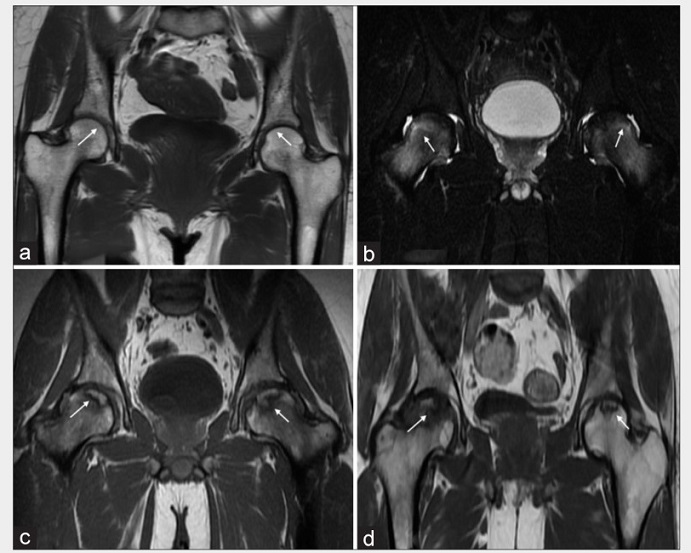Six Percent Of All Post-COVID Patients Who Have Hip Discomfort Likely To Have Developed Avascular Necrosis Of The Femoral Head!
Nikhil Prasad Fact checked by:Thailand Medical News Team Mar 10, 2024 1 year, 9 months, 3 weeks, 5 days, 15 hours, 40 minutes ago
COVID-19 News: The COVID-19 pandemic has presented an array of challenges, not least of which are the post-convalescence complications that affect various organ systems. One such complication gaining attention is avascular necrosis (AVN) of the femoral head, a condition where bone death occurs due to reduced blood supply. Two recent studies covered in this
COVID-19 News report, that were conducted independently in different parts of the world shed light on the occurrence and patterns of AVN in post-COVID patients experiencing hip discomfort.
 Six Percent Of All Post-COVID Patients Who Have Hip Discomfort Likely To Have Developed Avascular Necrosis Of The Femoral Head (a) Coronal MRI T1W image: Normal appearance of femoral heads, (b) coronal MRI STIR image: Bilateral Stage I AVN of femoral heads, (c) coronal MRI T1W image: Bilateral Stage II AVN of femoral head, and (d) coronal MRI T1W image: Right Stage III AVN of femoral head, left Stage II.
Study One: Insights from India
Six Percent Of All Post-COVID Patients Who Have Hip Discomfort Likely To Have Developed Avascular Necrosis Of The Femoral Head (a) Coronal MRI T1W image: Normal appearance of femoral heads, (b) coronal MRI STIR image: Bilateral Stage I AVN of femoral heads, (c) coronal MRI T1W image: Bilateral Stage II AVN of femoral head, and (d) coronal MRI T1W image: Right Stage III AVN of femoral head, left Stage II.
Study One: Insights from India
A study conducted at Dr Vikhe Patil Foundation’s Medical College and Hospital, Maharashtra, and Deenanath Mangeshkar Hospital, Pune, Maharashtra, India, aimed to analyze the spectrum of AVN in the femoral head through MRI images of patients treated for COVID-19.
Results from this study, encompassing 200 patients who received standard COVID-19 treatment and presented with hip pain, revealed that 6% of cases exhibited AVN. Interestingly, the majority of these cases were found in the younger population, particularly those below 40 years of age. No positive findings suggestive of AVN were observed in 94% of cases, indicating the importance of timely diagnosis and vigilant monitoring.
Discussion
The global use of corticosteroids in COVID-19 treatment has been on the rise, with reports of high doses and extended durations leading to steroid-induced AVN of the femoral head (SANFH). This study emphasizes the need for judicious steroid use, supported by timely diagnosis to prevent and treat SANFH effectively.
Globally, glucocorticoids have been implicated in the pathogenesis of SANFH. These steroids affect cholesterol emulsification, leading to the formation of small fat emboli that occlude blood vessels, causing ischemic necrosis in bone tissue.
Additionally, microRNA dysregulation has been identified in SANFH cases, inhibiting the repair of osteonecrotic bone. The study underscores the importance of careful steroid administration, especially in severe cases, as patients with mild COVID-19 may not require corticosteroids.
Early detection of AVN is crucial for effective management. Periodic MRI scans, particularly in high-risk patients, have shown high sensitivity in detecting AVN of the hip. The study recommends MRI scans at 3-, 6-, and 12-months post-steroid administration, as the onset of AVN can occur within this
timeframe.
Treatment modalities for AVN include medications like levodopa, which reduces osteocyte apoptosis, and alendronate sodium, which inhibits bone resorption. Hyperbaric oxygen treatment and extracorporeal shock wave therapy have also shown promise in promoting angiogenesis and improving bone function.
However, the study acknowledges its limitations, such as a small sample size and the absence of follow-up scans. The exact duration and dosage of steroid treatment during COVID-19 infection could not be ascertained, and histopathological correlations were hindered by the lack of femoral biopsy permissions.
The study findings were published in the peer reviewed Indian Journal of Musculoskeletal Radiology.
https://mss-ijmsr.com/mri-spectrum-of-avascular-necrosis-of-femoral-head-in-patients-treated-for-covid-19/
Study Two: Insights from China
A prospective observational study conducted at Tongji Hospital, Wuhan, China, aimed to investigate the occurrence of AVN in the femoral head in COVID-19 patients who had undergone conventional therapy and reported hip discomfort.
The study included individuals who received corticosteroid treatment for COVID-19 and reported hip discomfort within a six-month period from January 2022 to August 2022. MRI scans were conducted to assess changes in the hip joint.
Results from this study, involving 110 individuals who received corticosteroid treatment for COVID-19, revealed that 6% of cases exhibited AVN. Similar to the Indian study, the majority of cases were found in individuals below 40 years of age. The Ficat and Arlet classification system classified AVN stages, with Stage I being the most common (4.54% of cases).
The analysis revealed that AVN was absent in 91.81% of cases. However, Stage I AVN was identified in 4.54% of cases, Stage II AVN in 2.72% of cases, and Stage III AVN in 1.1% of cases. No instances of Stage IV AVN were observed.
The study concludes that AVN occurred in 6% of individuals who received standard therapy for COVID-19 and experienced hip discomfort. Notably, normal MRI findings were more common, while mild AVN (Stage I) was frequently observed in positive MRI scans in these post-COVID-19 settings.
The study findings were published in the peer reviewed journal: Hip International (Sage Journals).
https://journals.sagepub.com/doi/abs/10.1177/11207000241233906
Conclusion
These two independent studies provide valuable insights into the occurrence and patterns of AVN in post-COVID patients experiencing hip discomfort. The consistent finding of 6% incidence highlights the need for increased awareness within the medical community. Timely diagnosis, judicious steroid use, and vigilant monitoring, especially in high-risk populations, are crucial to managing AVN effectively.
As the world grapples with the aftermath of the COVID-19 pandemic, understanding and addressing post-convalescence complications, such as AVN, become imperative for comprehensive patient care. Further research, long-term follow-up studies, and global collaboration are essential to refine diagnostic and treatment approaches, ultimately improving outcomes for post-COVID patients.
For the latest
COVID-19 News, keep on logging to Thailand Medical News.
